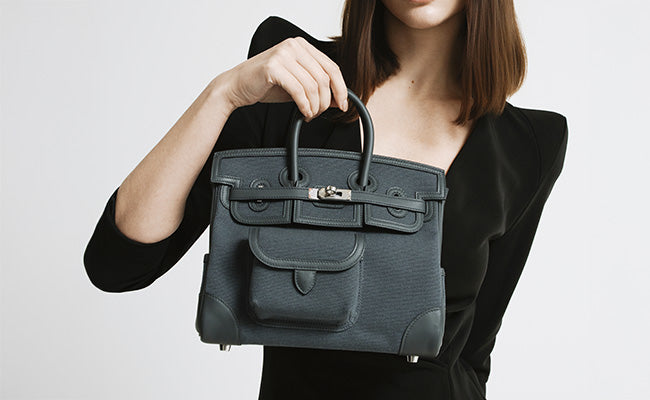
Shipping Insurance for High‑Value Handbags: What’s Covered?
Check out our Hermès collection and Birkin bags!
When we're shipping a coveted Birkin or that limited-edition Chanel clutch, the last thing we want is for it to disappear into the shipping abyss or arrive looking like it went through a blender.
Shipping insurance for high-value handbags typically covers theft, damage, loss, and misdelivery during transit, with coverage amounts based on the bag's declared value rather than standard carrier limits.
Unlike regular shipping insurance that might cap out at a few hundred dollars, specialized luxury handbag insurance recognizes these pieces for what they truly are: investments that can appreciate over time.
We've all heard those horror stories about vintage Hermès bags getting "lost" in transit or designer pieces arriving crushed because someone treated them like a regular package.
Standard carrier insurance often falls woefully short when it comes to luxury goods, sometimes excluding fashion items entirely or offering coverage that wouldn't even buy us a decent wallet, let alone replace a Kelly bag. The reality is that our beloved handbags need protection that matches their worth.
The good news? Proper shipping insurance for high-value handbags goes beyond basic coverage and actually addresses the unique risks these treasures face.
From authentication concerns to the specialized handling they require, comprehensive insurance policies understand that we're not just shipping accessories, we're shipping pieces of fashion history that deserve protection worthy of their pedigree.
Key Takeaways
- Specialized handbag shipping insurance covers the full declared value, unlike standard carrier insurance which often has low caps or excludes luxury items entirely
- Coverage includes theft, damage, loss, and misdelivery, with claims processes designed for high-value fashion goods
- Proper insurance protects both financial investment and brand reputation while meeting marketplace requirements for luxury item sales
What Shipping Insurance for High-Value Handbags Actually Covers
Shipping insurance for luxury handbags gives us financial protection against three main risks: loss, damage, and theft during transit. The coverage amount depends on your declared value, though insurers often cap payouts and exclude certain scenarios.
Loss, Damage, or Theft Explained
When we ship a precious Hermès Birkin or vintage Chanel, we're basically trusting strangers with items worth more than most people's cars. Shipping insurance steps in when things go sideways.
Loss coverage kicks in if your handbag vanishes entirely during transit. This includes packages that disappear from sorting facilities, fall off delivery trucks, or get delivered to the wrong address with no recovery possible.
Damage protection covers physical harm to your bag during shipping. This could be crushed boxes damaging hardware, water damage from leaky delivery vehicles, or rough handling that scratches leather surfaces.
Theft coverage applies when someone deliberately steals your package. This could happen at any point during transit, from warehouse theft to porch pirates snatching high-value deliveries.
Most policies require us to file claims within a specific timeframe, usually 30-60 days from the shipping date, but it varies.
Coverage Limits and Exclusions
Not every luxury handbag shipment qualifies for full protection. Insurers set strict limits and exclude certain scenarios.
Coverage caps usually range from $5,000 to $100,000 per shipment. Some specialized insurers offer higher limits for ultra-luxury items, but standard carrier insurance rarely exceeds $5,000.
Common exclusions include:
- Mysterious disappearance without proof of theft
- Damage from improper packaging
- Items shipped without proper documentation
- Counterfeit or replica bags
- Pre-existing damage not disclosed before shipping
Documentation requirements can make or break claims. We need original receipts, authentication certificates, and detailed photos showing the bag's condition before shipping.
Many insurers also exclude coverage for bags shipped internationally without proper customs declarations or those sent using basic shipping methods instead of premium services.
Full Reimbursement Versus Declared Value
The relationship between what we declare and what we receive isn’t always straightforward.
Declared value is the amount we state our handbag is worth when we buy insurance. This sets the maximum possible payout, not a guarantee of full reimbursement.
Full reimbursement depends on proving the bag's actual value through documentation. For a Hermès Kelly worth $15,000, we'd need receipts, appraisals, or recent comparable sales data to justify the full declared amount.
Depreciation factors can reduce payouts. Some insurers apply depreciation schedules, especially for vintage pieces or bags showing wear.
Market value considerations might work for or against us. If our limited-edition bag has appreciated since purchase, we might only get the original price unless we've updated the declared value.
Smart collectors usually declare values based on current replacement costs, not just what they paid, especially for rare or discontinued models that have gone up in value.
Types of Shipping Insurance for Designer Handbags
When shipping that coveted Birkin or limited-edition Chanel, you’ve got three main insurance options. Each one comes with different coverage limits, claim processes, and suitability for high-value designer pieces.
Carrier-Offered Insurance
Most major shipping carriers like Canada Post, UPS, and FedEx provide basic insurance coverage that's often insufficient for designer handbags. Standard coverage usually caps at $100-$200 CAD, barely enough for a wallet, let alone a $15,000 Hermès Kelly.
Coverage Limits by Carrier:
- Canada Post: $100 standard coverage, up to $5,000 with additional fees
- UPS: $100 standard coverage, with higher limits available upon request
- FedEx: $100 standard coverage, with declared value options for higher coverage (typically up to about $50,000 for parcel services)
Claiming through carriers can be slow and bureaucratic. They want lots of documentation and may even dispute luxury item valuations. Some carriers exclude high-value items from their standard policies.
Pros: Easy to add during shipping
Cons: Low coverage, complex claims, exclusions for luxury goods
Third-Party Insurers Like Parcel Pro
Third-party insurers fill the gaps left by carrier insurance. Companies like Parcel Pro, U-PIC, and others offer higher coverage limits designed for valuable items like designer handbags.
They typically charge 1-3% of the item's declared value. For a $5,000 Chanel, that’s about $50-$150 for solid coverage.
Key Benefits:
- Coverage up to $50,000+ CAD
- Faster claim processing (often 5-10 business days)
- Experience with luxury valuations
- Fewer exclusions for designer goods
Third-party providers understand the luxury market better than standard carriers. They’re more likely to accept authenticity certificates and appraisals as valid documentation.
The application process is usually pretty simple, item photos, proof of value, and shipping details.
Specialty Insurance for Luxury Goods
Specialty insurers focus just on high-value items and know the unique needs of luxury handbag shipping. These providers offer the most comprehensive coverage, but at premium rates.
Specialty Coverage Features:
- Full replacement value based on current market prices
- Worldwide coverage including international shipping
- No deductibles for most policies
- Authentication disputes coverage
Companies like Assetsure and other luxury-focused insurers tailor policies for designer handbags. They work with authentication services and keep up with market fluctuations for limited editions.
Premiums range from 2-5% of the item's value, but coverage includes scenarios standard insurers won’t touch, like authentication disputes, market value changes, and even some cases of buyer's remorse claims.
Best for: Ultra-high-value pieces ($10,000+), rare or vintage items, international shipping to luxury markets
These policies often throw in extras like professional packaging advice and preferred carrier partnerships.
The Unique Risks of Shipping High-Value Handbags
When we ship Birkins or Kellys, we're not dealing with ordinary packages. These luxury investments face threats during transit, from opportunistic thieves to mishandling by carriers who just don’t get the craftsmanship involved.
Theft During Transit
Designer handbags become prime targets as soon as they enter the shipping network. Criminals spot luxury shipments through recognizable packaging, tracking info, or even insider tips from shipping facilities.
Package thieves keep an eye out for shipments from known luxury retailers. They’ll watch delivery trucks in upscale neighbourhoods, too.
Common theft scenarios:
- Porch pirates swiping unattended deliveries
- Warehouse employees accessing packages during sorting
- Hijacking delivery trucks with multiple luxury items
- Mail room theft in apartment buildings
A $15,000 Hermès bag is a lot of value in a small, easy-to-conceal package. That makes these bags particularly tempting for thieves.
Professional theft rings often target specific brands. They study shipping patterns and may even place fake orders to spot vulnerable routes.
Damage from Improper Handling
Our handbags need specialized care, standard shipping just doesn’t cut it. Exotic leathers like crocodile or ostrich get especially cranky with temperature swings and moisture.
Shipping facilities usually lack climate control. Leather goods can crack, warp, or develop permanent creases in extreme weather.
Critical handling issues:
- Crushing from heavy packages stacked above
- Exposure to liquids from leaking parcels
- Temperature extremes in cargo holds
- Rough sorting machinery scratching hardware
Most carriers don’t train staff for luxury goods. They treat a $20,000 Kelly like any other box, risking damage to leather or hardware.
Authentication gets tricky if original packaging is damaged. Even small cosmetic flaws can wreck resale value and make authenticity harder to prove.
International Shipment Challenges
Crossing borders adds more headaches to handbag shipments. Customs inspections often mean unpacking and handling by folks who don’t know luxury protocols.
International risks:
- Longer transit times, more theft opportunities
- Customs delays in uncontrolled storage
- Documentation errors causing shipment holds
- Currency swings affecting declared values
Shipping luxury goods internationally brings extra scrutiny. Some countries have strict import rules or need special permits for high-value fashion items.
Counterfeit worries slow down customs clearance. Officials may hold up authentic bags to check legitimacy, exposing them to damage or theft.
Insurance rules vary by country. Domestic coverage might not work internationally, leaving gaps when it matters most.
Language barriers can cause documentation mistakes that mess up insurance claims. Incorrect descriptions or values might void coverage just when you need it.
How to Ensure You're Properly Covered
Getting the declared value right and understanding what your shipping insurance actually covers can make the difference between full compensation and a painful loss. We’ve got to pick coverage that matches our bag’s real worth and dodge common policy pitfalls.
Correctly Declaring Value
The declared value is the backbone of our shipping insurance. We need to declare the full replacement cost of our handbag, not just what we paid.
For limited edition Birkins or discontinued Kellys, we should use current market value from reputable resellers like Fashionphile or The RealReal. A bag bought for $15,000 might be worth $25,000 now, and that’s what we need to declare.
Documentation matters:
- Original purchase receipts
- Recent appraisals from certified pros
- Screenshots of comparable sales from luxury resellers
- Authentication certificates
Don’t undervalue to save on premiums. If your $20,000 Constance gets damaged and you only declared $12,000, you’ll only get $12,000 tops.
Understanding Policy Exclusions
Standard shipping insurance doesn’t cover everything, and luxury handbags face some specific exclusions.
Common exclusions:
- Wear and tear from normal handling
- Damage from poor packaging
- Loss due to insufficient packing materials
- Items shipped to conflict zones
- Certain exotic leather restrictions
Temperature and humidity damage often fall under "inherent vice" exclusions. Your crocodile Birkin could crack in extreme cold, and standard policies might not cover that.
Some insurers won’t cover bags made from certain exotic skins or with precious metal hardware. Double-check your bag’s materials before shipping.
War, civil unrest, and "acts of God" aren’t covered. Neither are losses from customs confiscation.
Choosing the Right Coverage for Your Bag
Different handbags need different coverage, depending on value, rarity, and destination.
For bags over $50,000, third-party insurance like Parcel Pro usually beats carrier options. They offer up to $150,000 coverage with fewer exclusions.
Coverage by bag type:
| Bag Value | Recommended Coverage | Special Notes |
|---|---|---|
| Under $10,000 | Carrier insurance | Usually enough |
| $10,000-$50,000 | Enhanced carrier or third-party | Add signature requirements |
| Over $50,000 | Specialized third-party | Door-to-door coverage is key |
For international shipments, look for coverage that includes customs delays and possible duties. Some policies even reimburse shipping costs for expedited replacements.
Signature requirements are a must for high-value shipments. FedEx insists on signatures for packages over $500, UPS starts at $1,000.
Consider "all-risk" coverage over "named perils." All-risk covers everything except specific exclusions; named perils only covers listed scenarios.
How the Claims Process Works for Handbag Shipments
When your precious Hermès Kelly or Birkin gets lost or damaged in transit, knowing exactly how to navigate the claims process can mean the difference between full compensation and a frustrating headache. The process typically involves three critical phases: proper filing procedures, comprehensive documentation, and understanding realistic timelines.
Filing a Claim Step by Step
When something goes wrong with a handbag shipment, it’s best to act quickly. Most insurance providers want claims filed within 30 days of delivery, or when the bag was supposed to arrive.
Step 1: Contact the carrier first. Report the issue to FedEx, UPS, or whichever shipping company you used within 24-48 hours. This gets the problem on their radar.
Step 2: Notify your insurance provider right away. Call or email them as soon as you spot the problem. Waiting too long just makes things messier.
Step 3: Fill out the claim form completely. Insurance companies ask for details about the handbag’s condition, value, and exactly what happened.
Step 4: Gather and submit all the documents they want. You’ll need photos, receipts, shipping records, anything that backs up your story.
Honestly, jumping on the process early makes everything less stressful. Waiting only adds headaches.
Documents You'll Need
Having the paperwork ready can seriously speed things up. Insurance companies get extra picky when it comes to luxury handbags.
You’ll want:
- The original purchase receipt or invoice
- Authentication certificates (especially for Hermès, Chanel, or Louis Vuitton)
- Clear pre-shipping photos showing the bag’s condition
- Shipping receipt and tracking info
- Delivery confirmation or photos of any damage
Professional appraisals are a must for vintage or rare pieces. It’s way easier to get these before shipping, not after something’s gone wrong.
Packaging evidence helps too. If you took photos of the bag packed up, or snapped pictures of damaged packaging, that’s gold for your case.
Some insurers also want repair estimates from authorized boutiques. Quotes from Hermès carry more weight than ones from a random leather shop.
Timelines and Pitfalls
Claims usually wrap up in 15-45 days, but luxury handbag claims can drag out. Authentication takes time, insurance companies want to be sure your Constance is the real deal and worth what you say.
Delays happen because of:
- Disputes over authenticity (especially with pre-owned bags)
- Not enough documentation
- Arguments about replacement value vs. depreciation
Things that slow you down: incomplete paperwork, blurry photos, or waiting too long to file. Claims sometimes get denied because someone waited weeks to report a damaged Evelyne.
A common mistake? Underestimating current market values. That Birkin you bought years ago might be worth a lot more now, but you’ll need solid proof.
Why Shipping Insurance Matters for Brand Reputation and Customer Satisfaction
When we’re talking about handbags worth thousands, shipping insurance isn’t just a box to tick, it’s a reflection of how seriously we treat our customers and our own standards. One lost or damaged Birkin with no coverage can turn a dream sale into a customer service trainwreck.
Protecting Your Brand's Image
Nothing screams “rookie move” like telling someone their $15,000 Hermès bag vanished in transit and there’s nothing you can do. In the luxury world, reputation lives and dies by how you handle every detail.
Pro retailers know insurance isn’t just about the money. It’s about looking like you’ve thought things through. Offering solid coverage says, “We’re on top of this, don’t worry.”
Luxury customers expect white-glove treatment from start to finish. If you’re relying on basic shipping insurance, usually $100 or less, you’re risking your reputation on the hope nothing goes wrong.
Maintaining Client Trust
Trust disappears fast when expensive handbags go missing. Customers want to know you’ll make it right if delivery goes sideways.
Insurance lets you promise a full replacement or refund without hesitation. That peace of mind can be the difference between a nervous buyer and a confident one.
Picture this: A client’s $8,000 Constance shows up damaged. With insurance, you can send a replacement right away. Without it, you’re stuck arguing with the carrier while your customer wonders if you’re legit.
The luxury handbag world is smaller than you’d think. Word travels, one badly handled claim can echo through forums and social media, undoing years of relationship-building.
Avoiding Unhappy Returns and Bad Reviews
Luxury shoppers do their homework. Negative reviews about shipping issues can sink sales faster than you can say “Himalayan Birkin.”
Bad reviews that call out shipping problems warn future customers you don’t have logistics under control. That’s a dealbreaker, especially for high-value pieces.
Insurance means you can fix shipping mishaps quickly. Instead of endless arguments with carriers, you can take care of the customer and move on. Sometimes, that’s all it takes to turn a frustrated buyer into a loyal fan.
Honestly, the cost of decent shipping insurance is nothing compared to losing customers, eating the cost of inventory, or battling chargebacks from claims gone wrong.
Frequently Asked Questions
When you’re investing in luxury handbags, it’s normal to have questions about keeping them safe during shipping. Here’s what you need to know about coverage, paperwork, and protecting those prized designer bags.
How does insurance protect my investment in a Birkin bag during transit?
Insurance for your Birkin covers you if the bag gets lost, stolen, or damaged while it’s being shipped. Since Birkins can run from $10,000 to well over $100,000, standard carrier insurance just doesn’t cut it.
Specialized insurance covers the bag’s full declared value. If anything happens, you get compensated based on what it’s actually worth now, not just what you paid years ago.
Coverage starts the moment the courier picks up your bag and lasts until it’s delivered. If someone drops it, scratches the leather, or it goes missing, you’re protected for the full amount.
What specific events are covered under high-value handbag shipping insurance?
These policies usually cover theft, loss, physical damage, and water damage during shipping. They’re built for luxury goods and the risks they face.
Physical damage means things like scratches, broken hardware, or crushed structure from rough handling. Water damage covers situations where your package gets soaked in transit or storage.
Loss and theft coverage protects you if the bag disappears or gets stolen from a delivery truck. Some policies even cover financial loss from delayed delivery, but that depends on the insurer.
Missing or damaged authentication cards and dust bags often count too, since they matter for resale value.
Can I insure my Chanel collection during international travel, and are there restrictions?
Yes, you can get insurance for your Chanel collection when shipping internationally, but coverage depends on the country. Some places have higher theft rates or tricky customs, so insurers might have restrictions.
You’ll need detailed photos, authenticity certificates, and receipts for international shipments. Customs forms should show the real value.
Some countries block luxury imports or have weird rules, so make sure your insurer knows the ropes to avoid gaps in coverage.
International transit takes longer, which raises the risk. Premium policies generally cover you for the whole journey, no matter how long it takes.
What's the maximum value I can insure for my Louis Vuitton pieces when using a courier service?
Specialized luxury shipping insurers usually cover individual Louis Vuitton pieces up to $50,000 or more. If you’re shipping a collection, coverage can go to $100,000 or higher per shipment.
Standard courier insurance is usually capped at $100 to $5,000, not enough for real Louis Vuitton. Third-party insurers fill that gap.
Some insurers offer unlimited coverage for rare, high-value pieces. If you’re shipping several items together, check if the coverage applies per item or for the whole shipment.
In the unfortunate event of a claim, what proof will I need to provide for my insured Prada handbag?
You’ll need to show the bag’s value, its condition before shipping, and what happened. Start with the original receipt or a recent appraisal.
Take clear photos before shipping, front, back, details, serial numbers, hardware, any wear or marks.
Include authentication certificates or proof you bought it from an authorized retailer. If it’s second-hand, add any paperwork about authenticity and condition.
For damage claims, snap photos of the packaging and the bag itself. Hang on to all shipping materials and any emails with the courier until the claim is sorted out.
Are there insurance options that cover both shipping and handling damage for my luxury handbag portfolio?
Absolutely, comprehensive luxury handbag insurance can cover your whole collection during shipping and handling. These policies know that accidents can happen at any stage, whether it’s packing, loading, or delivery.
If you’re someone who buys, sells, or moves several handbags often, portfolio coverage makes a lot of sense. Instead of juggling separate policies for each bag, you get to protect the entire collection under one umbrella.
Handling damage? That’s stuff like mistakes during packing at the sender’s place or when you’re unpacking at your end. This kind of coverage steps in for those all-too-human slip-ups that happen along the way.
Some insurers even have annual policies for collectors who ship bags regularly. Honestly, if you’re moving pieces around a lot, this route usually ends up cheaper than insuring every single shipment.




